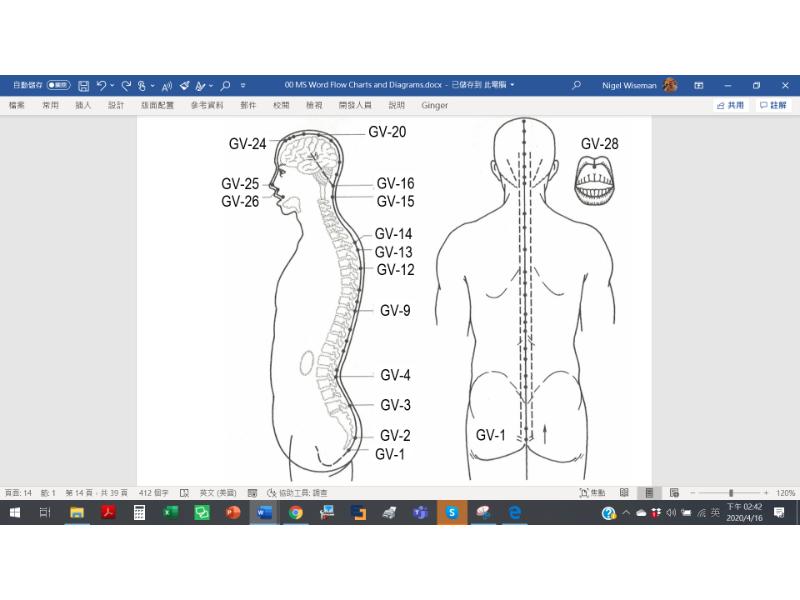Search in dictionary
Governing (dū) vessel
督脉 〔督脈〕 dū mài
Abbreviation: GV. One of the eight extraordinary vessels.
 |
| Governing (dū) vessel |
|---|
Functions
The governing (dū) vessel is the sea of the yáng vessels
and has special associations with the brain and kidney.
Sea of the yáng vessels
: The governing (dū) vessel traverses the back, which is the yáng aspect of the body’s surface. Since all six yáng channels converge at a point on its path, namely GV-14 (dà zhuī), the governing vessel has a regulating effect on the yáng channels, so it is said- to be the
sea of the yáng vessels.
- The governing (dū) vessel homes to the brain and nets the kidney. The kidney engenders marrow, and the brain is the
sea of marrow.
The kidney also governs reproduction, and reproductive problems are often treated by applying a supplementing stimulus at governing vessel points.
Governing Vessel Pathway
Overview
- Smaller abdomen → perineum →
inside spinal column → nape (GV-16) → brain →externally continuing over midline of head ðdown the forehead → face → nose → philtrum → upper gum. - Branch (1): spine → kidney.
- Branch (2): smaller abdomen → umbilicus → heart → throat → lower jaw → around the lips → center of eye socket.
- Branch (3): Inner canthus → forehead → brain → either side of nape → lumbus → kidney.
Description
Starts in the smaller abdomen (in the uterus in women and essence chamber in men) and emerges at the perineum. From here, it ascends the inside of the spinal column to just below the occipital bone on the nape (GV-16, fēng fǔ, Wind House), where it enters the cranium to the brain, while continuing externally along the midline over the vertex, down the forehead, nose, and philtrum to terminate at the upper gum (GV-28, 龈交 yín jiāo, Gum Intersection).
One branch (1) separates from the spine to home to the kidney.
Another branch (2) starts in the smaller abdomen, travels upward, passing through the umbilicus, heart, throat, to the lower jaw, where it skirts the lips before ascending to terminate below the center of each eye socket.
A third branch (3) starts at the inner canthus with the foot greater yáng (tài yáng) bladder channel, rises over the forehead to the vertex, netting the brain to emerge and splitting into two pathways to emerge at either side of the nape. The bilateral pathway then passes medially to the scapula, descending to the lumbus. It enters the muscle on their side of the spinal column to connect with the kidney.
Governing Vessel Acupoints
Indications of GV Acupoints
The 28 points on the governing vessels most treat arched-back rigidity, pain and stiffness in the back, child fright reversal, heavy-headedness, hemorrhoids, infertility, malarial disease, mania and withdrawal, and visceral agitation.
Major GV Acupoints
GV-4 (命门 mìng mén, Life Gate): Located on the lower back, inferior to the spinous process of the second lumbar vertebra.
- Indications: Impotence; seminal emission; vaginal discharge; menstrual irregularities; diarrhea; stiffness in the lumbar vertebrae.
- Stimulus: Needling: 0.5–0.8 cùn sideways and upward oblique insertion. Moxa: 3–15 cones; pole 20–30 min.
- Warnings: Moxa contraindicated for patients less than 20 years of age.
GV-5 (悬枢 xuán shū, Suspended Pivot): Located on the lower back, inferior to the spinous process of the first lumbar vertebra.
- Indications: Diarrhea; abdominal pain; painful stiffness of the lumbar vertebrae.
- Stimulus: Needling: 0.3–0.5 cùn sideways and upward oblique insertion. Moxa: 3–5 cones; pole 20–30 min.
| Indications for GV Points |
|---|
|
GV-6 (脊中 jǐ zhōng, Spinal Center): Located on the upper back, inferior to the spinous process of the eleventh thoracic vertebra.
- Indications: Diarrhea; jaundice; hemorrhoids; epilepsy; child gān accumulation; prolapse of the rectum.
- Stimulus: Needling: 0.3–0.5 cùn sideways and upward oblique insertion.
- Warnings: Moxa contraindicated.
GV-14 (大椎 dà zhuī, Great Hammer): Located on the upper back, inferior to the spinous process of the seventh cervical vertebra.
- Indications: Febrile disease; malarial disease; cough; panting; steaming bone tidal heat effusion; epilepsy; headache and stiff nape; wind papules.
- Stimulus: Needling: 0.5 cùn sideways and upward oblique insertion. Moxa: 3–15 cones; pole 15–30 min.
- Categories: Intersection point (jiāo huì xué) of the six yáng channels and the governing vessel.
GV-16 (风府 fēng fǔ, Wind House): Located on the posterior aspect of the neck, immediately inferior to the occipital bone on the midline.
- Indications: Headache; stiff nape; dizzy vision; painful swollen throat; loss of voice; mania and withdrawal; wind stroke.
- Stimulus: Needling: with the head tilted back, 0.4–0.6 cùn perpendicular (level, from back to front) insertion. Moxa: pole 3–5 min.
- Warning: Direct moxibustion contraindicated.
- Categories: Intersection point (jiāo huì xué) of the governing (dū) and yáng linking (yáng wéi) vessels; one of the thirteen ghost points.
GV-25 (素髎 sù liáo, White Bone-Hole): Located at the very tip of the nose.
- Indications: Nasal congestion; nosebleed; clouded spirit; clouding reversal; suffocation in newborns.
- Stimulus: Needling: 0.1–0.3 cùn upward oblique or perpendicular insertion.
- Warnings: Moxa contraindicated.
GV-26 (水沟 shuǐ gōu, Water Trough): Located superior to the upper lip, in the philtrum, one third of the distance from the base of the nasal septum to the red skin of the upper lip on the midline.
- Indications: Mania and withdrawal; epilepsy; child fright wind; clouded spirit; deviated eyes and mouth; painful stiffness of the lumbar vertebrae.
- Stimulus: Needling: 0.2–0.3 cùn upward oblique insertion. Moxa: 3 cones; pole 5–15 min.
- Categories: Intersection point (jiāo huì xué) of the governing vessel and the stomach and large intestine channels; one of the thirteen ghost points.